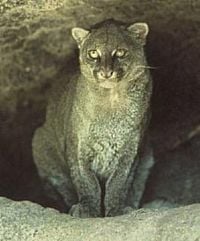Jaguarundi
| Jaguarundi[1] | ||||||||||||||
|---|---|---|---|---|---|---|---|---|---|---|---|---|---|---|
 | ||||||||||||||
| Scientific classification | ||||||||||||||
| ||||||||||||||
| Puma yagouaroundi (Geoffroy, 1803) | ||||||||||||||
 |
The jaguarundi (Puma yagouaroundi) is a medium-sized Mexican, Central and South American wild cat: average length 65 cm (30 inches) with 45 cm (20 in) of tail and a weight of about 6 kg (13.2 lbs). It has short legs and an appearance somewhat like an otter; the ears are short and rounded. The coat is unspotted, uniform in color, and varying from blackish to brownish gray (gray phase) or from foxy red to chestnut (red phase).
Etymology and naming
The two color phases were once thought to represent two distinct species; the gray one called jaguarundi, and the red one called eyra. However, these are the same species and both color phases may be found in the same litter. Its coat has no markings except for spots at birth. In some Spanish speaking countries, the jaguarundi is also called leoncillo, which means little lion. Other Spanish common names for the jaguarundi include: "gato colorado", "gato moro", "león brenero", "onza", and "tigrillo". [3]
Taxonomy and evolution
This cat is closely related to the much larger and heavier cougar as evident by its similar genetic structure and chromosome count; both species are in the genus Puma although it is sometimes classified under a separate genus, Herpailurus and until recently, both cats were classified under the genus Felis.
According to a 2006 genomic study of Felidae, an ancestor of today's Leopardus, Lynx, Puma, Prionailurus, and Felis lineages migrated across the Bering land bridge into the Americas approximately 8 to 8.5 million years ago. The lineages subsequently diverged in that order.[4]
Studies have indicated that the cougar and jaguarundi are next most closely related to the modern cheetah of Africa and western Asia,[4][5] but the relationship is unresolved. It has been suggested that ancestors of the cheetah diverged from the Puma lineage in the Americas and migrated back to Asia and Africa,[4][5] while other research suggests the cheetah diverged in the Old World itself.[6] The outline of small feline migration to the Americas is thus unclear (see also American cheetah).
Ecology
Its habitat is lowland brush areas close to a source of running water. It occasionally inhabits dense tropical areas as well. It is crepuscular and nocturnal depending on location. This cat is comfortable in trees, but prefers to hunt on the ground. It preys upon fish, small mammals, reptiles and birds.
Reproduction
The litter consists of one to four kittens. They are raised socially after a 70-day gestation. The kittens become mature at approximately 2 years of age.
Conservation
This cat is not particularly sought after for its fur, but it is suffering decline due to loss of habitat.
The jaguarundi has been sighted around the Guiana Space Centre in French Guiana.[7]
Subspecies
- Puma yagouaroundi armeghinoi, Western Argentina, Far-Eastern Chile
- Gulf Coast Jaguarundi, Puma yagouaroundi cacomitli, South Texas and eastern Mexico
- Puma yagouaroundi eyra, Brazil, Paraguay and Argentina
- Puma yagouaroundi fossata, southern Mexico to Honduras
- Puma yagouaroundi melantho, Peru and Brazil
- Puma yagouaroundi panamensis, Nicaragua to Ecuador
- Puma yagouaroundi tolteca, Arizona and western Mexico
- Puma yagouaroundi yagouaroundi, Guyana and Amazon Rainforest
ReferencesISBN links support NWE through referral fees
- ↑ W. C. Wozencraft, "Order Carnivora," in D. E. Wilson and D. M. Reeder (eds.), Mammal Species of the World: A Taxonomic and Geographic Reference. (Washington : Smithsonian Institution Press, 1993). ISBN 1560982179.
- ↑ Cat Specialist Group 2002. [1]. 2006 IUCN Red List of Threatened Species., World Conservation Union. Retrieved on 9 May 2006. Database entry includes justification for why this species is of least concern
- ↑ IUCN (2008). IUCN Red List of Threatened Species. Retrieved 2008-8-9.
- ↑ 4.0 4.1 4.2 Johnson, W.E., Eizirik, E., Pecon-Slattery, J., Murphy, W.J., Antunes, A., Teeling, E. & O'Brien, S.J. (6 January 2006). The Late Miocene radiation of modern Felidae: A genetic assessment. Science 311 (5757): 73–77.
- ↑ 5.0 5.1 Culver, M. and Johnson, W.E., Pecon-Slattery, J., O'Brein, S.J. (2000). Genomic Ancestry of the American Puma. Journal of Heredity 91 (3): 186–97.
- ↑ Barnett, Ross and Ian Barnes, Matthew J. Phillips, Larry D. Martin, C. Richard Harington, Jennifer A. Leonard, and Alan Cooper (9 August 2005). Evolution of the extinct Sabretooths and the American cheetah-like cat. Current Biology 15 (15): R589–R590.
- ↑ Centre Spatial Guyanais - Un florilège de faune sauvage au CSG
Caso, A., Lopez-Gonzalez, C., Payan, E., Eizirik, E., de Oliveira, T., Leite-Pitman, R., Kelly, M. & Valderrama, C. 2008. Puma yagouaroundi. In: IUCN 2008. 2008 IUCN Red List of Threatened Species. <www.iucnredlist.org>. Downloaded on 01 December 2008.
http://www.iucnredlist.org/details/9948
Rick, J. and B. Lundrigan. 2004. "Puma yagouaroundi" (On-line), Animal Diversity Web. Accessed December 01, 2008 at http://animaldiversity.ummz.umich.edu/site/accounts/information/Puma_yagouaroundi.html. http://animaldiversity.ummz.umich.edu/site/accounts/information/Puma_yagouaroundi.html
External links
- Stock photographs with a variety of examples from both coat phases
- Jaguarundi page and photos at bigcatrescue.org
- http://ds.dial.pipex.com/agarman/bco/jundi.htm
- http://ds.dial.pipex.com/agarman/jundi.htm
- http://lynx.uio.no/catfolk/yaguar01.htm
- http://www.jaguarundi.org
Credits
New World Encyclopedia writers and editors rewrote and completed the Wikipedia article in accordance with New World Encyclopedia standards. This article abides by terms of the Creative Commons CC-by-sa 3.0 License (CC-by-sa), which may be used and disseminated with proper attribution. Credit is due under the terms of this license that can reference both the New World Encyclopedia contributors and the selfless volunteer contributors of the Wikimedia Foundation. To cite this article click here for a list of acceptable citing formats.The history of earlier contributions by wikipedians is accessible to researchers here:
The history of this article since it was imported to New World Encyclopedia:
Note: Some restrictions may apply to use of individual images which are separately licensed.


